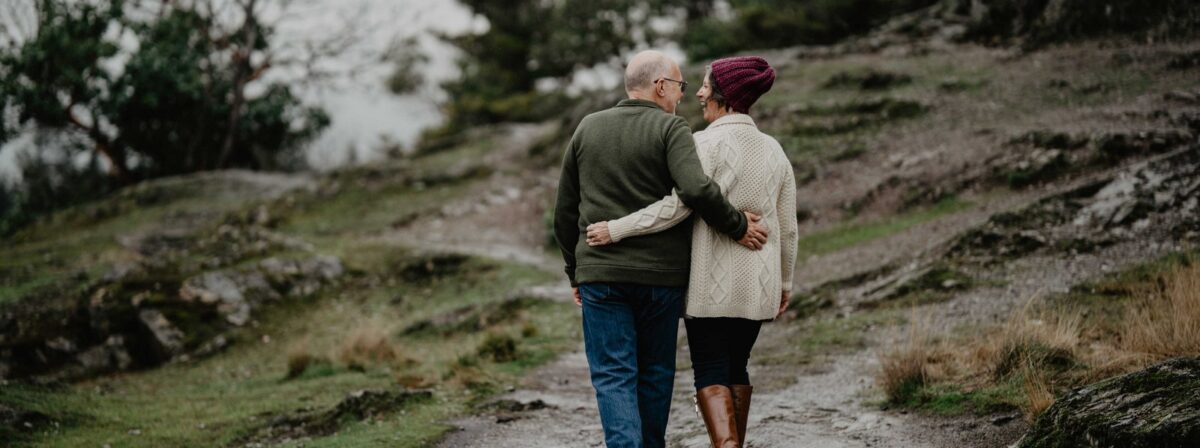
After a rainy and windy night, the temperature had dropped and we were happy with our decision yesterday to do a short hike up at the Chisos Basin as it surely would be a cold one up there today! With no rain in the forecast, we bundled up, made a lunch along with lots of water and drove out to park and hike out to Mule Ears Spring about 4 miles out and back. This would be a moderate hike and just right for us beginner hikers.
We set out from the parking lot and soon left all the people behind, having the desert pretty much to ourselves. The occasional hikers coming back gave a quick wave and hello as they passed. No one out here was anxious to disturb the quiet of the desert and it was just perfect. We were able to really enjoy and explore the diversity of this desert landscape, which was surprising in its richness of plant life. It was here where Jim truly began his new obsession with cactus. Last year, in Cuba, it was hood ornaments. Here, in West Texas, it became cactus. Many, many pictures of cactus fill our file for these days. I will spare you, dear readers, and include only a fraction. They are pretty fascinating, I have to admit. So many of them look like they might be soft and fuzzy only to let you know with the slightest touch that they will pierce you skin easily, so best beware!
This slideshow requires JavaScript.
We hiked slowly out to the spring where we were so surprised to find such greenery way out here – it was amazing!
This slideshow requires JavaScript.
We went a little further up along the trail as we wanted to get a better view of the backside of the Mule Ears. People who go backcountry camping can park back where we had and then hike way out for days I guess. The most important thing out here is water, so you would need to know what you were doing, but being so far away from everything, we could sure see the attraction – so peaceful! We stopped at a spot with a good view of the mountains and ate our lunch before finally setting out to head back.
This slideshow requires JavaScript.
On our return, we noticed the geology of the area and in particular were interested in the gray, fluffy looking rock that lined part of the trail. This is called Tuff and is volcanic ash from a long, long time ago. We remembered seeing similar rock up in Alberta at Drumheller and wondered if it were the same substance, which up there, is very slippery when wet. Jim very kindly demonstrated what could happen when walking over wet Tuff.
Our hike for the day finished, we headed back to Cottonwood Campground. We had paid for another two nights and so were able to relax for the evening, knowing we had another night after this one in this lovely, quiet oasis. Late at night, as we headed to the bathroom, we enjoyed the spectacular night sky once more as the clouds had cleared away. We had heard from other campers that Javalinas (an animal that looked a lot like a pig but is from the rodent famliy) had been in the campground every night. But, try as we might, we were never able to see any out there – bummer!
The next day we headed out for a short (.5 mile) hike in Tuff Canyon. It was a small canyon along the roadway and we were interested to see the rock formations there. We enjoyed wandering and climbing the rocks for about an hour. Nothing strenuous at all, but very interesting!
This slideshow requires JavaScript.
After our canyon hike, we continued on out of the west entrance to the park to the small town of Terlingua where we wanted to check out their “ghost town”. Arriving there, it seemed as if the whole town was actually a ghost town – not a whole lot there. However, they did have an interesting general store and a great little coffee shop where we enjoyed lattes in the sun while using their wifi – we felt pretty civilized after the last few days!
From the coffee shop, we checked out the many abandoned homes here. Terlingua was once a thriving mining town, but once the mine ran out, the town emptied out, leaving many homes to fall into ruin. It was interesting to look through them and then tour the cemetery which overlooks the old mine.
This slideshow requires JavaScript.
From there, we headed back for our last night at Cottonwood Campground. In the morning, the plan was to get up early and drive over to Rio Grande Campground on the other side of the park and about 1 1/2 hours away – wow! This really is a BIG park!!! Hopefully, by showing up early, we would find a spot to stay for the night, but that’s another blog post! Thanks for reading!



Anne Hepp
April 28, 2020 at 1:53pmNot unlike bears you can often smell the javelina before you see them! They are very musky.
Sue and Jim
April 28, 2020 at 6:52pmWe did not know that – so interesting! I’m not sure how I would have felt about seeing them out in the open in our campground – probably would have scared me to death! lol